

 The Accurate Reloading Forums
The Accurate Reloading Forums  THE ACCURATE RELOADING.COM FORUMS
THE ACCURATE RELOADING.COM FORUMS  Guns, Politics, Gunsmithing & Reloading
Guns, Politics, Gunsmithing & Reloading  Reloading
Reloading  6.5x55 Improved load ladder with RL22 (pics)
6.5x55 Improved load ladder with RL22 (pics)Go  | New  | Find  | Notify  | Tools  | Reply  |  |
| one of us |
Posted - 06/06/2005 : 9:50:38 PM -------------------------------------------------------------------------------- Alright gents, I will post this both for the folks who would care, and those who are maybe looking to gain some understanding of the lingo and techniques used to determine the "sweet spot" for a particular barrel/rifle/load combo. Earlier in another post nononsense mentioned that posting these pics would help greatly, those who are entering into the handloading game. I wish I had them back when I THOUGHTI had an grasp of the accuracy game and loading for it. This is IMHO the fastest and most accurate way to find your rifle's preference for any chosen combination of bullet and powder. The Ladder method was developed by Creighton Audette (do a search, this ain't the friggin library) the theory states that by loading 1 load at a time with your chosen powder and bullet, and increasing by .2gr increments in small cases, and .3gr increments in large cases, you can shoot a "ladder" of increasing charges which will yield clusters of several bullets within a charge range, as the shots "walk up" the paper. This is done by firing ONE bullet of each charge range, then on the the next highest range, and so on. IMHO, to do it this way, at least 300yds needs to be used to get the dispersion between the bullets to be interpretable with the acceptance of human error. Now, there is also another theory that I incorporate called "Optimal Charge Weight" theory. This is Dan Newberry's version (still not the library). What he sais is that by loading your ladder in multiple sets and fired "round robin" style, you can more effectively spread the human error across the data set. What you do in this test, instead of using 1 target with 1 aimpoint and firing your ladder, you use a target for each charge wieght. Now, you fire each new charge weight at a different target with the same POA. Then, you repeat the ladder up to say 4-5 times using that same process so that 4-5 rnds of the same charge have been fired at their respective targets. However, by firing them in the ladder order instead of the 5 shot string of same charge weight method, you will more evenly disperse the human error acorss the groups. You will see a far better set of data using this alteration of the Creighton Audette method as it was origninaly. Now, as to harmonics, your barrel will vibrate in it's own frequency. Every barrel is different, but many in similar lengths, chamberings, twists, etc will fall into very similar harmonic frequency. A barrel's vibrational rotation as a bullet passes throught the bore and exits the muzzle, will resmeble the shape of the "infinity" symbol. The goal is to load your rounds so that they will exit the muzzle as the barrel is passing the center point of that cycle where it is the most uniform and stable. At this point, your loads will be the best match for your barrel and chambering and will be REPEATABLY accurate. So here is the load ladder results, fired round robin, for RL22 in fireformed Lapua brass, match prepped, with FGGM 210 primers, and the impressive 140gr A-MAX pill from a PacNor 1:8 Twist 26" select match SS 4 groove tube that is a staright taper form 1.125"-.920", chambered for the 6.5x55 Ackely Improved caliber on a blueprinter WIN70 action with a jewell trigger, HS Precision Stealth stock, Badger ordnance tactical 20MOA base and tactical rings (lapped) and a Nightforce NXS 8-32x56mm Scope with the R2 reticle. The ladder was fired at 200yds. The first ladder can very easily be seen to be higher as the first 5 rounds I used to foul the bore in on the clean barrel were obviously not enough to settle her in. The next 4 ladders POI will prove to be consistent with a properly fouled bore. 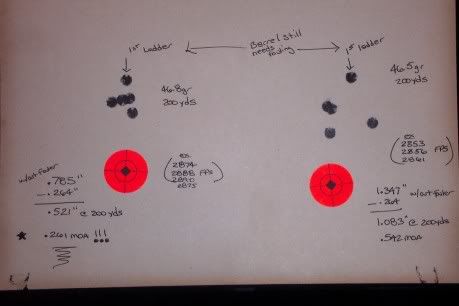 notice the first group of 46.5gr shows not much promise, but has begun to create a more circular pattern, indicative of an approaching sweet spot (nearing the middle of the infinty shaper cycle) Also notice the high POI for the first ladder while fouling the bore. Now, see how the 46.8gr load is tighter and more centered. This group at 200yds shows a sweet spot has been touched upon. 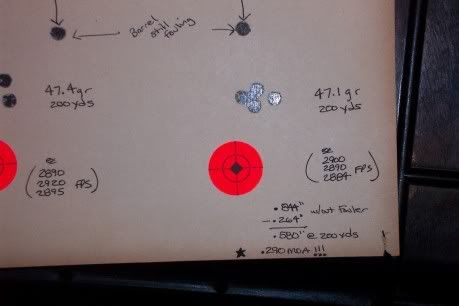 Now, take notice that this 47.1gr load is STILL in the sweet spot (only .3gr increase) and has really tightened up. 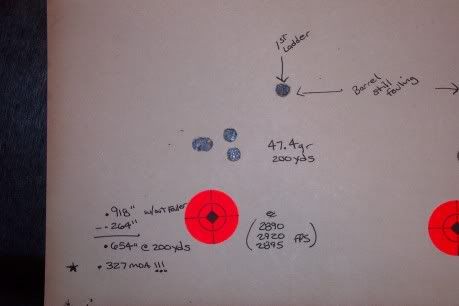 47.4gr is at the end of the sweet cycle. with maybe a hint of horizontle dispersion appearing now.  AND, as if majic were afoot, the group spreads back out horizonatly and verticaly after only another .3gr increase. This shows that the bullet is exiting the muzzle at variuos points in the cycle shaped like the "infinity" symbol. Picture the bore rotating in that motion, and the bullet exiting at variuos points, and you can see how these groups appear like this, it is NOT coincidence. 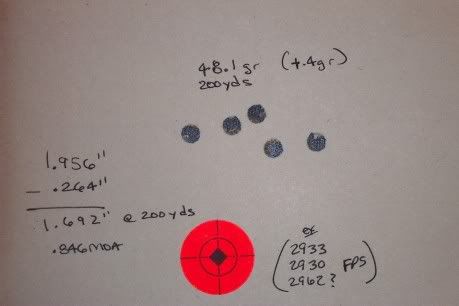 Now the next .4gr increase (in a hurry), the group is slightly less in size, but still resembles the last group. 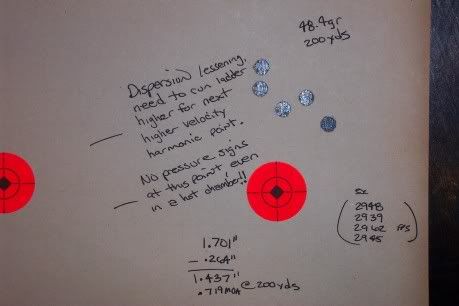 And finally we end up at the 48.4gr load which as you can see has started to "walk" back together showing the bullets are now entering a zone where they exit the bore closer to center of the vibration and are starting to "centralize" themselves. Had I run the ladder up another few charges, the groups would have come back together to resemble the first set that were in the "sweet spot". These two charge ranges will be referred to as the "lower harmonic" and the "higher harmonic" point respectively. Hope this provides some help for new loaders and yields some data for those who may be interested in the caliber or bullet used. Difficulty is inevitable Misery is optional | ||
|
| one of us |
For any of you who choose to do the "Searches", you will generally find I totally disagreed with each and every section of Rookie Greens(dan's) bastardization of the excellent Creighton Audette Method. But, I completely agree with everything JustC did until he hit Rookie Green's bastardized recommendation. If my memory is correct, Rookie Green encouraged folks to do about 5 things differently, including the Round Robin fiasco. Some of the 5 were Un-Safe and JustC did not include them. The reason people do not want to do the Round Robin fiasco is because at distance, by the time you get through all the groups while taking time to let the barrel cool every 5 shots or so, a whole lot of time has passed. And that means the wind conditions are totally different from when the initial shot on target #1 was fired. The only thing the Round Robin accomplishes is to increase your chance that the wind will have more effect on your groups. And therefore your ability to shoot the "best groups possible" at each Load increment is reduced. If you feel you are "inducing human error", then you need to STOP shooting and recover your concentration level. And of course, call shots you think have a high probability of being a "flier" and eliminate it from group consideration. So, if you are shooting 3-shot groups or 5-shot groups, I'd recommend you go back to Mr. Audette's Method and shoot each Load increment together in a focused, controlled, short time period. That does not mean w-i-d-e o-p-e-n, sound like a semi-auto mode though. --- Nothing has ever been done to improve upon Mr. Audette's original Method. | |||
|
| one of us |
I though the whole point of Audette's method was to NOT have to fire 5 shot groups! I thought that the idea was to be able to efficiently test multiple bullet/powder combinations in order to focus on the more promissing ones!So, for example, a combination of Speer Hot Core and IMR 4350 might be ruled out after firing just 10-15 rounds. In this case, JustC has a very accurate rifle, so he will have many combinations that will be accurate, but only a few that will be very accurate. Remember, that the next step will be to vary seating depth, which we havn't got to yet! To put it another way, I see Audette's method as a way of eliminating ineffective combinations. That's my opinion FWIW. Having said that, very impresive 200 yeard groups! Peter. Be without fear in the face of your enemies. Be brave and upright, that God may love thee. Speak the truth always, even if it leads to your death. Safeguard the helpless and do no wrong; | |||
|
| One of Us |
I find all the info presented by Just C, very informative! Thanks for taking the time and the energy to do the testing and posting the results! Cheers seafire | |||
|
| one of us |
Hot Core,..I have been getting data sets that are much more consistent IMHO. My non-preffered groups resemble the same patterns, even in various calibers, rifles, scopes, bullet designs, etc. The only similarity is the gunsmith who builds them. I understand your logic behind the audette method as it were, and I used to do it that way. But, on a whim I tried the "round robin" method of firing multiple ladders at multiple targets, and I am getting results which are far more uniform from rifle to rifle. Now, maybe that shows I am shooting better because of some subconcious decision that this way is better, I don't know the answer to that. I do know, that my groups seem to show a greater correlation to load ranges then when I fired them in strings of like loads. This is working for me until I can disprove it, and I am always trying. peter, I am a beleiver that in order to get the vertical dispersion needed to interpret the original ladder of increasing loads fired 1x each, you REALLY NEED 300yds. I have tried it at 200yds and just a great big hole with a few flyers. But this round robin method has shown harmonic preferences even at 100yds, which is really very close to be testing loads IMHO seafire, thanks for the vote of confidence and the assessment is mutual. I am always very pleased when the theory actually manifests itself on paper, just as it was supposed to. That always makes me feel like I had a great range session, because I KNOW i have a good data set to save me a lot of time and wasted barrel life. I like the whole science end of this sport, don't ask me why, but it is satisfying to prove things to yourself,..ya know what I mean? Grin as to 200yds and elapsed time, I will usually shoot the ladder on a day which is overcast to begin with, so I can max out my magnification with no mirage. Most of the time, these overcast days will quite often be very light winded, or have a period before the rain, or dark, that the winds will drop out. That is when I am setting up my gear. It took me maybe 1 1/2hrs for that ladder, with the last 2 ladders being fired back to back for 14rnds in one string (hence the "hot chamber" notes) I don't shoot on bad days, I leave work early on the good shooting days. Overcast and still, that is a load ladder day. I have even been reprimanded by the wife for leaving the house to go to the farm on a dead calm, overcast day when I had stayed home with the flu!!!! but hey, when the wind is right, gotta grab a rig and go with it. Difficulty is inevitable Misery is optional | |||
|
| one of us |
JustC, you are absolutely right about needing 300 yards, especially for a rifle like yours! Now, my Ruger Ultralight will be fine at 200 or maybe even 100! peter. Be without fear in the face of your enemies. Be brave and upright, that God may love thee. Speak the truth always, even if it leads to your death. Safeguard the helpless and do no wrong; | |||
|
| one of us |
Hey Peter, You are 100% correct. The Audette Method is for 1-shot at each load level on a single target. Then you look for the clusters and reload a series for testing to see which of the clusters is more accurate. I don't believe Mr. Audette mentioned Fine Tuning as a Final Step by varying the Seating Depth, but I agree with you and do the same thing. --- By the way Peter, I certainly appreciate your mentioning the above. In my mind, I was already at the "cluster" stage in following JustC's post and I absolutely should have mentioned that. It seems the older I get, the more my concentration drifts. Not good for shooting or (apparently) discussing it without some folks to pull me back on track. Thanks again! | |||
|
| one of us |
Hey JustC, If it works better for you with the Round Robin, then by all means do it. For a very long time I did a whole lot of long distance shooting at very small targets. Environmental changes during even a short 2-3 minute span have the ability to shift "my" Point-of-Impact. And I've seen what it does to the folks I'm shooting with. So, I'd just have more confidence in re-shooting the "clusters" as individuals in a fairly short time. Anything else I say could be misunderstood as arguing with you, and that is not my intent. You have some fine groups that anyone would be proud of. Of course it makes me wonder how good they "could have been" if you had done it right. | |||
|
| one of us |
hot core,..of course I will load them as strings when I have the few charge ranges figured out. I'll run them prolly at 300yds to determine which is the most consistent. I just run the ladders at a slow and deliberate pace, so my shooting is as consistent as possible, and the groups give me a true representation of the load/rifle, and not my error or haste. I actually fixed this rig up for the 600yd matches, and it looks thus far like she is gonna do the deed. I still want to run the lapua 139gr scenars and the 140gr bergers after powder charges are correct. Difficulty is inevitable Misery is optional | |||
|
| one of us |
Hey JustC, It does look like a potentially excellent rig for distance shooting. Best of luck to you in your Matches. | |||
|
| one of us |
Very interesting . If you have a sweet spot with that bullet at 2900fps.... now change powder and fine tune it to give 2900fps and will it also be a "sweet spot?"- ie can you tune a reload using a chrono? | |||
|
| one of us |
That I would have to experiment with. My first SWAG would be to say NO. I would "theorize" that different burn rates of various powders, would lend different pressure curves and therefore although another load may fall into a harmonic near the same MV, that that would be a function of that powder being close in burn rate, but if a very different load were used with a much slower/faster powder, that the MV would be different at the point at which the barrel would prefer it. But that is only a guess?? Difficulty is inevitable Misery is optional | |||
|
| one of us |
I'll go with a 100-1 longshot "maybe". The barrel is being subjected to some very interesting Load and Stress conditions from shot-to-shot and Load-to-Load. It is easy for most folks to understand that upon firing, the Internal Pressure causes a swell in the Chamber area between the Bolt Face and Bullet. It moves down the barrel with the Bullet at "varying rates" as the Powder burns. This actually causes the barrel to shorten and lengthen. We also have the Load and Stress of the Bullet trying to go straight ahead while the Lands and Grooves are forcing it to spin. That has the barrel twisting and relaxing as the Bullet transitions the barrel and as the Internal Pressure slightly varies along the way. These two combine to cause the tip of the muzzle to move in an elongated figure " 8 " movement and it can be skewed either right or left and is typically refered to as the Barrel Harmonic. You also have the Recoil beginning to raise the barrel at the moment of ignition. All of these things can be seen when shooting the Audette Method on a single target at distance with increasing Loads. Using any different "component" (including Powder) changes the Internal Pressure "Rate of Change and Duration", which therefore alters the Harmonic. When you see people comment about multiple brands of Bullets and Loads striking at the same Point-of-Impact, they are typically seeing this at a relatively close distance of 50-100yds or so. Once you begin shooting at distance, the difference in the Harmonic becomes easier to see and the Point-of-Impact will shift(in no particular direction. So, there is always a chance the random harmonics could occur from Load-to-Load at the time the Bullet exits the muzzle, but it is really unlikely. | |||
|
| Powered by Social Strata |
| Please Wait. Your request is being processed... |
|
 The Accurate Reloading Forums
The Accurate Reloading Forums  THE ACCURATE RELOADING.COM FORUMS
THE ACCURATE RELOADING.COM FORUMS  Guns, Politics, Gunsmithing & Reloading
Guns, Politics, Gunsmithing & Reloading  Reloading
Reloading  6.5x55 Improved load ladder with RL22 (pics)
6.5x55 Improved load ladder with RL22 (pics)

Visit our on-line store for AR Memorabilia

